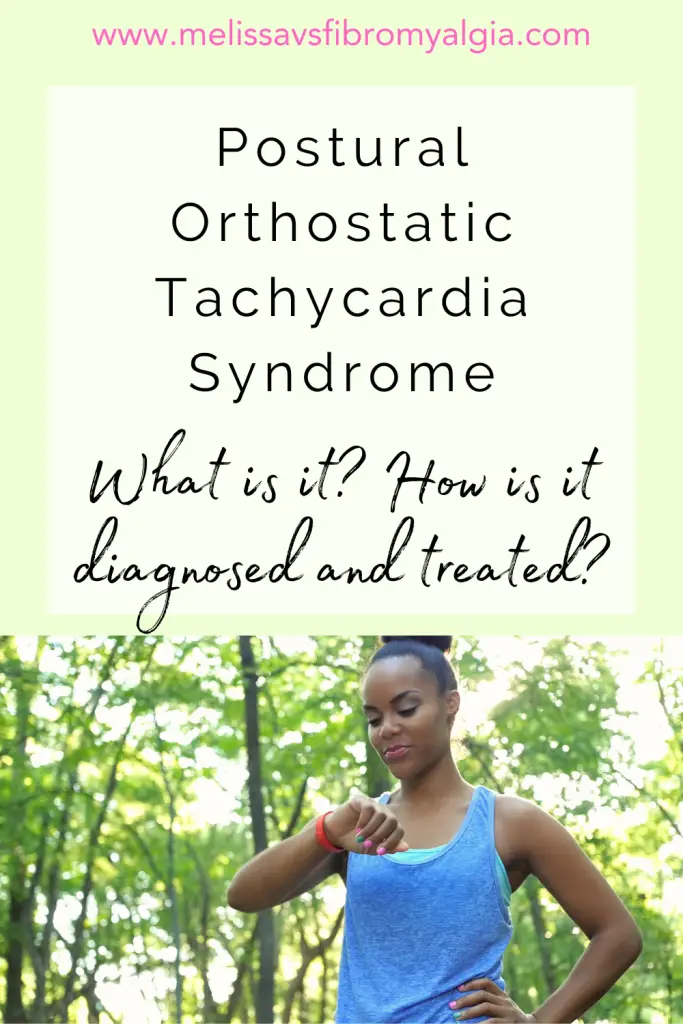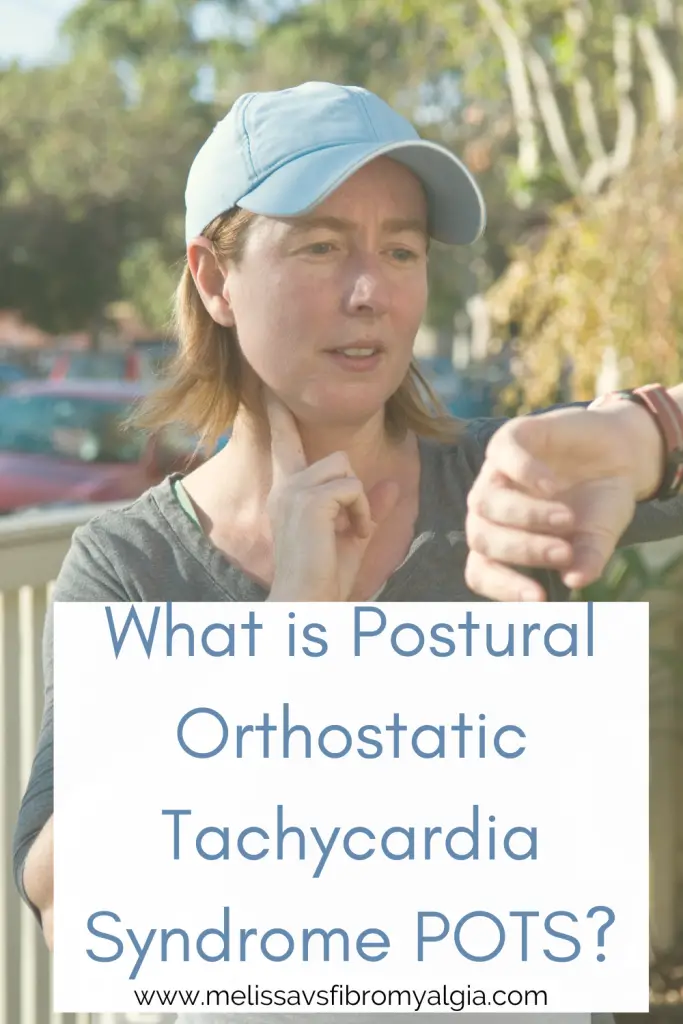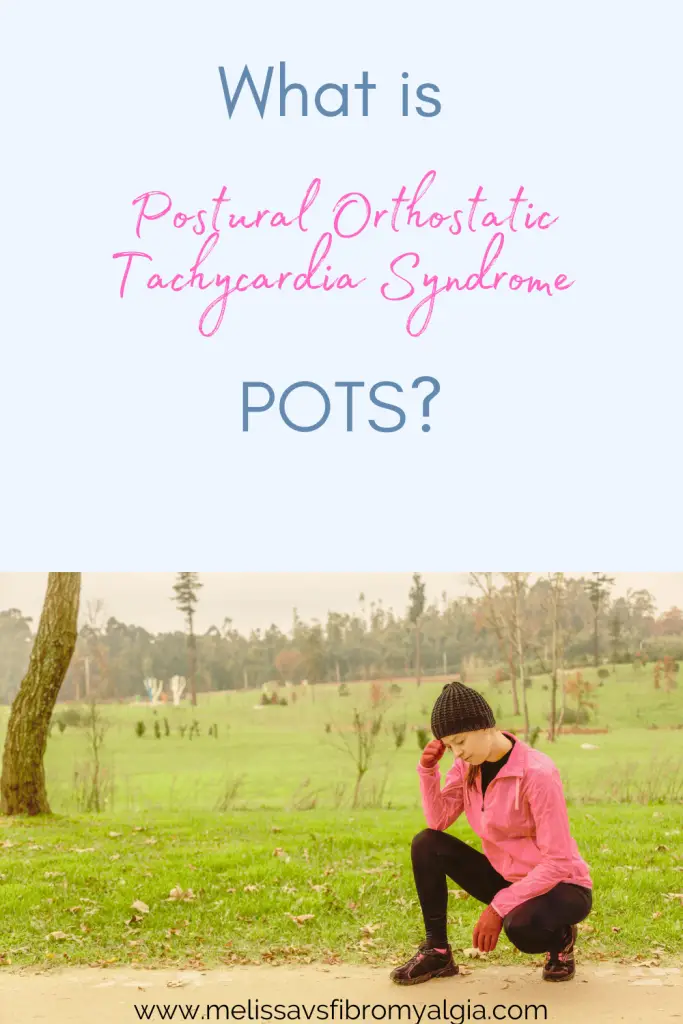POTS, Postural Orthostatic Tachycardia Syndrome, is a blood circulation disorder that is often related to fibromyalgia (FMS) and chronic fatigue syndrome/myalgic encephalomyelitis (CFS/ME).

It comes under the umbrella dysautonomia – a group disorders of the autonomic nervous system. This system governs our involuntary functions like breathing, heart beat, digestion etc. There are several conditions caused by dysautonomia including POTS. You can learn more about dysautonomia here.
What does POTS stand for?
Postural Orthostatic Tachycardia Syndrome. This means a group of symptoms related to your posture (standing) and your heart rate.
What are the symptoms of POTS?
- Light headedness
- Fainting or near fainting
- Brain fog
- Fatigue (it can be severe and long-lasting)
- Exercise intolerance
- Nausea
- Headache
- Heart palpitations/beating fast
- Blurry vision
- Tremor
- Nausea
- Excessive sweating
- Pale face
It sounds quite familiar to most of us, no? No wonder it’s hard to differentiate between CFS/ME, FMS and POTS.
Someone with POTS will also experience a heartrate increase of 30 beats or more per minute upon standing. However, I experience most of the above symptoms and my doctor found I experienced 22 beats per minute at the clinic – however it would be more reliable to do this test at differing times. More in diagnosis below.

What makes POTS worse?
- Heat (climate, hot baths etc.)
- A lot of standing
- Not enough fluid and salt
- Sickness (I experience worse symptoms when I have an infection and post operation)
- Stress (like sickness/infection and other)
What causes the heart rate to rise upon standing?
They don’t know the exact cause of POTS. But they believe the symptoms are caused by lower blood circulation, blood pooling upon standing and certain hormones.
What is the prevalence of POTS?
It’s quite common and they currently believe the estimate to be anywhere between one and six million Americans depending on your source. I can’t find a worldwide prevalence. This article estimates around 0.2% in the general population. I suspect the numbers are not quite right as many people go undiagnosed.
Who gets POTS?
The vast majority are women, but men do also develop it. Usually of childbearing age, but other ages do get it. It can vary across the menstrual cycle.
This article from Hopkins Medicine says, “POTS is less common in young children, but it affects adolescents, and symptoms often develop during puberty. POTS may begin after an apparent or confirmed viral illness, but it can also appear following surgery and other health events.”
POTS can run in family and may be associated with hypermobility disorders (often associated with fibromyalgia and ME/CFS too!)

POTS and Pregnancy
Similar to fibromyalgia and ME/CFS, POTS presents differently to different people in pregnancy. For some it’s temporarily better, others it can be worse.
The same article as above says, “Other complications of pregnancy appear to occur at about the same rate for women with POTS, and their newborns seem to be as healthy as infants born to mothers without POTS.”
I believe that how we do in pregnancy does depend on how our overall health is prior to pregnancy. My first two pregnancies were difficult because my health issues were wildly uncontrolled prior to them. My second two were much easier (easier not easy) because my symptoms were better managed.
To learn more about pregnancy and fibromyalgia see this article by Dr Ginevra
How do you diagnose POTS?
In a local GP practice you may experience a simple test such as checking your heart rate from sitting to standing. Your history and symptoms provide a big clue. There are other tests they can do to replicate the tilt table test.
However, the formal diagnosis requires a tilt table test. One is tilts from supine to upright and their heart rate is checked. The test sounds like torture to me.
During the test your heart rate will rise at least 30 beats per minute.
You will also have several of the symptoms listed above.
Orthostatic hypotension must be ruled out. This is blood pressure lowering upon standing. As an example, I have low blood pressure (the bottom of normal) but it stays stable when I stand.
What can you do to support discussions on whether you have this?
I recommend symptom tracking for this very purpose. Keep a note of your symptoms. If you have a Fitbit or other health tracker, this can be of us. Seeing what your heart rate is doing upon standing and walking around can be useful information.
For many years my symptoms were buried under the ginormous pot of chronic fatigue symptoms and covered over by the constant pain and chronic insomnia. In short, it’s hard to tell the difference between chronic fatigue syndrome, fibromyalgia and POTS (and other related conditions). So keep up your history with your doctor (tell them what you can), write it all down and see the patterns.
Many of the treatment options below are easy to do yourself with no side effects. It could be worth trying some. Fatigue management is always a good support.
How do you treat/support yourself with POTS?
The first line is to discuss this with your doctor. Sodium is a usual first line treatment for POTS but it may not be right for you – people with high blood pressure may not be recommended to consume salt.
- Consume plenty of salt and fluids
- Avoid or minimize caffeine and alcohol
- Avoid or minimize precipitating factors (i.e.. heat if you know that causes symptoms)
- Gently exercise in a way that is safe for you (start lying down if you need to, start low and go slow)
- Practice stress relieving techniques such as breathwork
- Compression garments
- Squeeze your legs together, or squat if you can, during an intense episode
- Pace yourself (good chronic fatigue management)
- Raise the head of your bed slightly
- Medications (there are medications to help the kidneys retain sodium, improve blood volume, reduce the heart rate and improve blood vessel constriction)
Summary
POTS is a treatable condition, but it can be debilitating, and it can hide in plain sight. I hope this information helps you with your journey.
References for you to look up
Hopkins Medicine article on POTS https://www.hopkinsmedicine.org/health/conditions-and-diseases/postural-orthostatic-tachycardia-syndrome-pots
Dysautonomia information https://my.clevelandclinic.org/health/diseases/6004-dysautonomia
From American College of Cardiology https://www.acc.org/Latest-in-Cardiology/Articles/2016/01/25/14/01/Postural-Tachycardia-Syndrome-POTS-Diagnosis-and-Treatment-Basics-and-New-Developments
